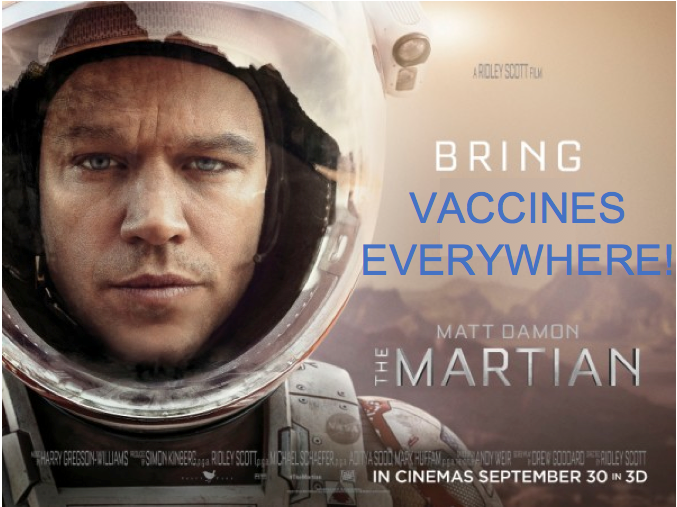Getting to “Mars” with immunization delivery
|

Official movie poster (copyright 20th Century Fox), with a few creative tweaks by Laura Edison.
With the recent NASA discovery of water on Mars, combined with the release of my new favorite movie, The Martian, Mars has been on my mind a lot lately. While watching the movie, I was struck not only by the physical beauty of both Mars and Matt Damon, but also by the incredible amount of coordination and planning that it takes to travel through space. And as a vaccine advocate, that got me thinking.
With space travel—whether fictional or real—the mission is usually to explore something, but most of the investments and planning have to do with getting there. In the case of The Martian, a fictional NASA sends a manned mission to Mars to analyze soil samples. But NASA would never send a crew of astronauts to explore Mars without a high-tech spaceship, a meticulously planned flight trajectory, and a well-trained professional team manning the control center, tracking data sent from the spaceship in order to respond as needed. The vast majority of manpower, time, and resources are spent on the journey—because no matter how exciting the goals are for the exploration of Mars, the astronauts will not be able to accomplish anything if they don't first get there (and get home, too… cough, Matt Damon).
With immunization, our goals—such as those laid out by the Sustainable Development Goals—are to protect children from deadly and disabling diseases. But just like exploring Mars, we can't get to that goal without the journey: getting vaccines to the right places, at the right time, and at the right temperature. This is where the supply chain comes in.
The immunization supply chain is the entire system that supports the delivery of vaccines from the manufacturer to communities. To succeed in protecting kids (or “exploring Mars”), you need not only the vaccines themselves but also cold chain equipment (spaceships) to transport them, real-time data to help decision-makers (command center) respond to changing needs, a well-planned supply system design (flight trajectory), and, of course, professionally trained supply chain workers (astronauts) to carry out the mission. Supply chains for other commodities, such as oral rehydration solution and zinc for treating diarrhea, work much the same way.
While the planning and coordination part of space travel may not be the most “exciting” part of The Martian, the mission would have been an immediate failure without it—likely resulting in deaths of the astronauts. In order to end the hundreds of thousands of real deaths of children here on earth from vaccine-preventable illnesses such as rotavirus diarrhea and pneumococcal pneumonia every year, we need to apply these same principles to immunization supply chains. I am currently working on a project that aims to use advocacy to help make that a reality.
Current supply chains are outdated and under-resourced. Problems like lack of electricity, muddy roads, flat tires, untrained and poorly paid workers, malfunctioning equipment, and paper-based data systems prevent vaccines from being delivered efficiently and effectively. By investing in next-generation immunization supply chains that include things like accessible, high-quality data, direct-drive solar-powered refrigerators, integration with other health commodity supply chains, and, where appropriate, outsourcing to the private sector, we can ensure that vaccines are delivered and their lifesaving potential is fulfilled. For example, it is estimated that, if successfully delivered, pneumococcal and rotavirus vaccines could avert more than 11 million child deaths in low- and middle-income countries by 2030.
While the real NASA has not yet succeeded in sending a manned mission to Mars, it is planning to do so in the near future (fingers crossed!). NASA doesn't expect to get to Mars without significant investment in planning, coordination, data, training, and equipment for the journey—and the global health community shouldn't, either. To reach our “Mars” of protecting every child everywhere from vaccine-preventable diseases, we need to get to work on the supply chain.
-- Laura Edison Kallen is a Scientific Communications Associate at PATH.














